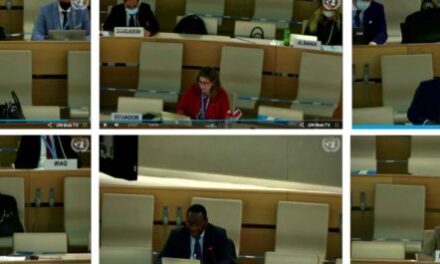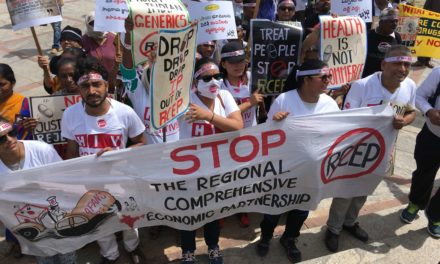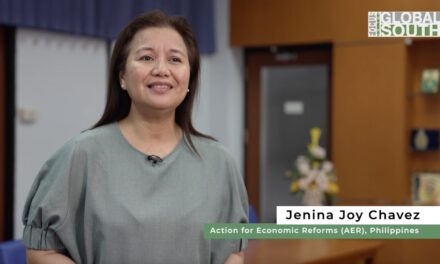GENEVA, 19 February 2007: Whilst the WTO Doha negotiations have formally resumed, most negotiators in Geneva are in the dark about what is really going on. There are no formal agriculture meetings of the membership. The agriculture committee chair, New Zealand ambassador Crawford Falconer is regularly holding informal ‘fireside chats’ to which only about 23 – 25 delegations are invited. (1) These meetings are only for ambassadors. A meeting of the African Group in Geneva on Friday 16 February saw African delegates expressing anger over the fact that they have been excluded from these talks. Of the entire continent, only Benin, as the spokesperson for the West African cotton issue, is on the ‘fireside chat’ invitation list – a bitter irony given DG Pascal Lamy’s proclamations that the round is most important for Africa.
In the recent weeks, however, the real talks, it seems, are between the US and EU, although the G4 [US, EU, India and Brazil] in meeting this week in London and a Brazil- India meeting scheduled for 5 March.
The format of negotiating amongst the G6 (US, EU, India, Brazil, Australia and Japan), the ‘real negotiating forum’ before the talks collapsed in July last year, has been disbanded. USTR Susan Schwab commented in a press conference that the G6 forum was not useful. Instead, she has been advocating a ‘reverse engineering’ approach.
US-EU REVERSE ENGINEERING – BLAIR HOUSE ACCORD BY ANOTHER NAME?
According to one developing country delegate, Schwab’s ‘reverse engineering’ is the process whereby the US and EU set the market access tariff cutting formula aside in their negotiations, and instead focus on the products of market access interest to each other, or products which are sensitive for their domestic constituencies. Agreement is worked out between them product by product. After that, the tariff cutting formula to be applied multilaterally, as well as the treatment for sensitive products, will be worked out to fit in with the bilateral agreement.
When they have decided upon their desired package, the talks are then expanded to include first India and Brazil, and then a small group of other members (probably those in the fireside chats). The majority of WTO members are finally presented with a take-it-or-leave it package.
This process is not new. The Uruguay Round was infamously concluded only after the US and EU met in Blair House (the official state guest house for the US President in Washington), and came up with the ‘Blair House Accord’ which they then proposed to the rest of the Membership for endorsement as a multilateral deal.
Informally commenting on the current state of affairs and their exclusion from the process, one African delegate, whose country has not been invited to the fireside chats lamented:
« We are not having a multilateral process, but the bialteral and plurilateral agreements are being ‘processed’ and passed through the multilateral route just to justify that the membership is on board. In
actual fact, we are not having a member -driven negotiation. »
He continued:
« Resumption? This is a false resumption. The process is to legitimise the deal that the US and EU may come up with. Perhaps they felt that they were close to the conclusion of a deal or they were making progresss, and they want the rest of the membership to endorse what they come up with, so they called for a ‘resumption’. But the reality is that the rest of the membership is just sitting there waiting. The chair’s informal sessions [open to all members held once in two or so weeks] is simply about information. You are told for example that the fireside chats did not make progress. It is a waste of time. These
[open-ended meetings] are not negotiating meetings. »
WASHINGTON POLITICS – FARM BILL AND TPA
Whether Congress will give the Bush administration an extension on the trade promotion authority (TPA or « fast-track ») when it expires on 1 July 2007 will determine the life or death of the round. However, as one US official shared informally, the extension does not have to be in place by 1 July when the current TPA expires. It could well be that there is a lapse of several months before Congress agrees to a new TPA
for the purposes of concluding Doha and several free trade agreements (FTAs), for example with Peru, Panama, Colombia, South Korea. Obviously though, US trade representative Schwab’s negotiating authority vis-a-vis her trade partners would be diminished if TPA lapses. A hard campaign is ongoing in Washington. Labour and environmental clauses for the FTAs are being discussed in order to draw the Democrats on board. Also, Democrats representing farm interests are being courted and asked what they want to get out of Doha and the Farm Bill. Whether the Administration’s campaign will be successful remains to be seen.
On 1 February, the Administration unveiled 65 proposals for the US Farm Bill to Congress. Whilst these remain only at the proposal stage, the trends are not particularly encouraging. More box shifting is being planned – moving subsidies from WTO illegal categories to direct payments which, in the WTO, falls under the unlimited « green box ». In fact the US already houses about 70% of its subsidies under the
green box, which the WTO cotton case has revealed is anything but non-trade distorting. These moves towards direct payments will simply make hide export subsidies and trade distortions. The increase in
direct payments could be up to 5.5 billion. This means that US can declare that it is WTO compatible, but in reality it will still be distorting trade.
Unfortunately, this deceptive game of box-shifting could unlock the current deadlock in the Doha Round. Due to high commodity prices because of biofuels and high global demand, so-called ‘trade distorting supports’ of the US amounted to 11.5 billion in 2006, down from about 19 billion the previous year. In its last official agriculture offer in the WTO, in October 2005, US proposed binding their trade distorting supports at 22 billion. The G20 rejected this, and has asked the US to bring supports down to 12.5 billion.
The US could conceivably accept the G20 position at this point. If so, the only stumbling block in the domestic supports pillar would be disciplines on the blue and green boxes. Hopefully, the G20 will wake
up to and push for strong disciplines in thegreen box – they have articulated some of these disciplines but seem not to have pushed them hard in the negotiations.
In market access, a source close to the Brazilian negotiating team said that whilst the EU’s Peter Mandelson has made it known that he is willing to accept the G20 market access position of 54% tariff cuts, gaps between EU and Brazil still remain. The EU apparently wants to cut tariffs based on averages (even as they are asking deveoping countries to cut NAMA tariffs line by line), whilst the G20 is asking for line-by-line cuts. There are also remaining differences in the coverage and treatment of sensitive products.
NON-AGRICULTURE MARKET ACCESS (NAMA)
In NAMA, Canadian Ambassador Donald Stephenson has also been holding some informal consultations (similar to the fireside chats in agriculture). At these meetings, Stephenson has been exploring the different ideas of ‘level of ambition’. Whilst it does not make much sense that one sector is traded off with another in the negotiations, WTO negotiators are generally aiming for ambition in agriculture to be more or less matched by ambition in NAMA and Services. That is, if tariffs in agriculture are cut by 54%, those in NAMA may not be too far from that percentage also.
Since the resumption, the US and EU have, as in services, attempted to intensify the NAMA negotiations. This approach was rejected by developing countries. India reportedly said that this round is about agriculture since that is the sector that is most distorted and it would be impossible to finalise figures for NAMA before the figures in agriculture emerge.
There has been disagreement around the concept of ‘level of ambition’, with the chair attempting to equate level of ambition as ‘tariffs minus flexibilities plus sectorals’. The NAMA 11 [including Argentina, Brazil, Egypt, India, Indonesia, Namibia, Philippines, South Africa, Tunisia and Venezuela] were opposed to that – their reasoning being that flexibities should be a completely separate issue from the tariff formula (this is the same position NAMA 11 held on to last year) and should not be accounted for in the ‘level of ambition’. They also said that sectorals were completely voluntary and should not also be a factor.
The EU is still pushing hard for coefficients of 10 for developed countries and 15 for developing countries in the Swiss formula, that is maximum tariffs of 10 and 15 respectively. US was reported to have been
silent on the issue of coefficients. They are apparently facing difficulties at home in the manufacturing sector and may not be even keen on an across the board coeffient of 10 for themselves. The two sectors which are sensitive for them are automobiles and textiles. (2) Instead, the US remains very aggressive in pushing for sectoral negotiations. A sectoral approach to liberalisation is in their interest since they want low to zero tariffs in most sectors, but high tariffs in textiles. They have tried in NAMA to push for a ‘positive sectoral’ in textiles, that is higher tariffs than the formula would yield, but this effort did not seem to go far in the negotiations last year.
Talks are also taking place on non-tariff barriers (NTBs) and the non-legally binding mechanism for settling NTBs.
SERVICES
There were attempts at the end January Davos meeting by US and EU to get developing countries to agree to a date for the revision of their services offers. Again, developing countries have chosen to wait for clearer indication in agriculture before committing themselves further. No date has been set. Explaining why developing countries have not bitten the bait, a Caribbean delegate says, « They (the US and EU) are attempting to have low ambition in agriculture and high ambition in services and NAMA. Given the current situation (where nothing has emerged in agriculture), there is no way I can account to my capital why I need to provide a revised offer. »
Nevertheless, informal services clusters are taking place in the last two weeks of every month. The February cluster will deal with rules rather than market access – including domestic regulation and the emergency safeguard mechanism.
The domestic regulation talks have been continuing under the chairmanship of the Singapore’s Peter Govindasamy. He has dealt with the following issues at his meetings – transparency, technical standards, necessity test and development. With each meeting, he has been working with groups on parts of the domestic regulation text.
Positions however, remain far apart. The US has said clearly that it will not be forced to agree to a necessity test. If one is included in the text, there will be no domestic regulation negotiations. EU used to be silent on the issue, but is also now saying no to the necessity test. Switzerland, Australia, India, and Hong Kong China are amongst the delegations pushing for the necessity test. The end result, some speculate, could be a ‘best endeavour’ necessity test.
However, the US has been aggressively pushing ‘prior comment’ under transparency. That is, countries need to notify the WTO membership before changing their domestic regulation, and be open to receiving feedback from other delegations about their proposed changes in regulation. Developing countries are opposed to this – it would give other countries an avenue to interfere in domestic policies. Also, developing countries have argued that they do not have the institutional capacity to enforce such an agreement. The current text is based on the US position and could be watered down into best endeavour language.
The development concerns of the ACP countries have not been endorsed by developed countries such as the US, which fears that what the ACP is asking for could amount to too many loopholes in the agreement. In addition, the major players are apparently not agreeing to carve outs for LDCs! All in all, there remain many differences.
FORECLOSING DEVELOPING COUNTRIES’ DEVELOPMENT PROSPECTS
History does not seem to have changed, and we seem to be reliving the end days of the Urugauy Round negotiations.
Poverty in Africa has doubled in the past 25 years under structural adjustment policies. UNCTAD has already revealed that even in the recent years, when some LDCs have experienced positive economic growth, and increased exports, poverty has not declined. In Comoros, Malawi, Mali, Tanzania and Zambia, GDP growth has not translated to higher consumption per capita i.e. no decrease in poverty.(3) Harvard’s Dani Rodrik concludes that poor African countries can grow, but they cannot seem to sustain their growth. (4) This is probably connected to the findings of UNCTAD economist S.M. Shafaeddin, who cites the examples of Jamaica, Ghana, Colombia, Uruguay and Paraguay – all countries which have had high or moderate levels of growth rates in exports in the recent years, but have had negative manufactured value (MVA) added. That is, even as countries are growing in exports, there has been a process of deindustrialisation. Ghana’s MVA was at -3.5% during the 1990s, indicating severe deindustrialisation.(5)
These issues have not been discussed in the multilateral trade institution. Instead, Doha negotiations and its fixed formulas liberalising all sectors and products line-by-line, and permanently, is being negotiated, with outcomes experts have already predicted will amount to losses for the poor.(6)
* Aileen Kwa is a research associate with Focus on the Glabal South based in Geneva.
NOTES
1. The group Falconer has pulled together includes Argentina, Australia, Bangladesh, Benin, Brazil, Canada, Chad, Chile, China, Costa Rica, Croatia, EC, India, Korea, Indonesia, Japan, Malaysia, Norway, Paraguay, Switzerland, Thailand, US and Uruguay.
2. Since Bush came into power in 2001, 1 in 5 manufacturing jobs have disappeared, totaling over 96 million jobs. Auto makers and textile companies have been hardest hit. (Klapper B ‘WTO’s 150 Members to Meet Amid Uncertainty about US’ AP, 7 February 2007).
3. UNCTAD 2006 LDC Report.
4. Rodrik D 2006 ‘Goodbye Washington Consensus, Hello Washington Confusion’, January.
5. Shafaeddin S.M. 2005 ‘Trade Liberalisation and Economic Reform in Developing Countries: Structural Change or De-Industrialisation?’ UNCTAD Discussion Papers No. 179 April.
6. See Wise T and Gallagher K 2006 ‘Doha Round and Developing Countries: Will the Doha Deal Do More Harm Than Good?’ also, Polaski S 2006 ‘Winners and Losers: Impact of the Doha Round’.









